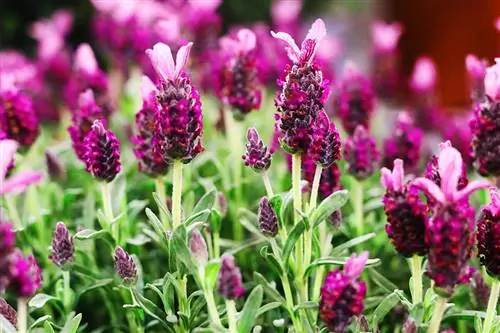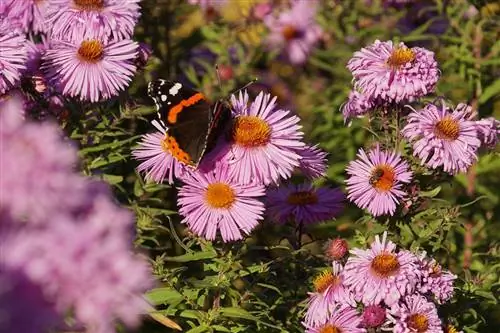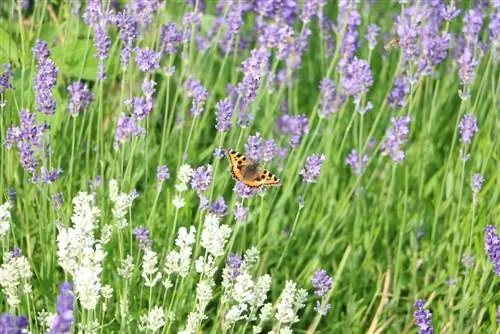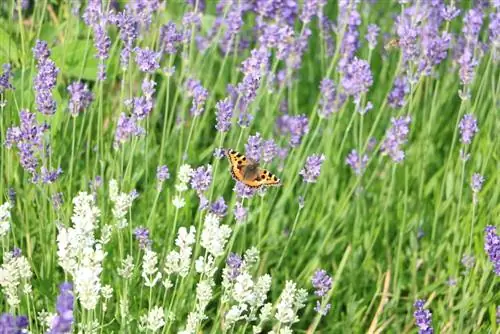- Author admin [email protected].
- Public 2023-12-17 03:39.
- Last modified 2025-06-01 06:48.
Butterfly lavender - the scent that summer is made of. Medium-height perennials, silver foliage and flower spikes in Mediterranean colors. The evergreen perennial from the Mediterranean region with its aromatic scent and unusual shape is an eye-catcher everywhere.
Profile
As a summer beauty, it likes to impress in beds and borders, but butterfly lavender also thrives in balcony boxes and pots. Butterfly lavender (Latin: Lavandula stoechas), also known as lavender and sometimes as French lavender, comes in many colors: violet, pink and of course the famous lavender-blue are among the most popular splashes of color on balconies and terraces. The subshrub, which comes from the mint family (Lamiaceae), is also one of the favorites in the garden for local bees and butterflies. If the butterfly lavender is cut back early, a second wave of flowers is imminent. The crested or butterfly lavender reaches a height of 40 to 50 cm. But lavender is not hardy.
The butterfly lavender at a glance:
- multicolored species
- smells of camphor
- Flowering months from May to September
- sunny location
- Planting time from January to December
- Growth height approx. 40 cm
- Planting distance 30 to 40 cm
- hardy with winter protection
- Butterfly Plant
- Bee food plant
- Centuries-old medicinal, aromatic and spice plant.
Care
The leaves of the crested or butterfly lavender are narrow, silvery-green and have an aromatic scent. Its expressive flower spikes appear from May onwards and form distinctive flags up to 5 cm long - hence its name. Lavender is a typical companion plant for roses, although butterfly lavender's preference for lime-free and sandy soils must be taken into account. However, lavender feels really at home in rock gardens and in pots. If the flowers are pruned early, new flowers will appear again by September. The butterfly lavender has several subspecies, with particularly frost-sensitive species native to Portugal and Turkey:
- Italian lavender (Lavandula stoechas subsp. stoechas): Short-stemmed flowers, a variety from the Mediterranean region.
- Spanish lavender (Lavandula stoechas subsp. pedunculata, syn. L. pedunculata): Long-stemmed flowers, native to central Spain and northeast Portugal, a more commonly cultivated species.
Location
To develop its full aroma, lavender needs long hours of sunshine and a protected place. A very warm and sunny location, but without extreme sunlight, is ideal.
Pouring
Less is more - that also applies to butterfly lavender. The lavender prefers it dry to too wet, but the root ball must never dry out completely. As soon as the top layer of soil has dried thoroughly, add some lime-free (or well stale) water.
Substrate & Soil
The soil must be well-drained to avoid waterlogging. The substrate can be acidic or neutral, but must always be lime-free (i.e. not alkaline). If possible, add some sand to the substrate.
Sowing/Planting
Sowing can be done at any time of the year. Lavender seeds need water, warmth and light. They are lightly pressed into the breeding soil and carefully sprayed with water. The seeds germinate after three to four weeks.
The warm months of June to July are suitable for sowing outdoors. With a planting distance of 30 to 40 cm, the plant has enough space to develop.
Recommended for sowing:
- a nutrient-poor substrate (e.g. potting soil or coconut fiber)
- even humidity
- cover with air-permeable foil
- ventilate briefly every three days.
Propagate
Lavender can be propagated from seeds (specialist shops), although not all seeds will probably germinate and not all seedlings will produce identical plants. An alternative is cutting cuttings or cuttings (for example from pruning). The 15 cm long cuttings (with wood) are ideally broken out of the mother plant - and not cut. Lowerers initially remain on the plant. A long branch is pressed into the ground in spring, freed from leaves, fixed and covered with earth. In autumn it becomes clear whether the sinker has developed its own roots and can be cut off from the mother plant. Another option is to divide the plant, for example when digging it out of the garden or repotting it. The best time to share is autumn.
Diseases and pests
The lavender is well equipped to ward off pests because its essential oils are extremely unpopular. However, diseases can develop due to improper care. Too much moisture leads to root rot or mold formation. Dark spots on lavender are also an indication of a fungal disease. If care is made incorrectly, the plant is removed from the substrate, the roots are washed out and replanted in nutrient-poor but lime-free substrate. Remove affected plant parts beforehand.
Fertilize
The nutrient requirements of butterfly lavender are low and in soil that is too nutrient-rich the plant becomes lazy to bloom. Planted lavender plants receive a small amount of fertilizer in spring, such as a commercially available fertilizer for ornamental gardens. The potted specimens are supplied with a plant fertilizer at half the concentration every month from April to September. If you want, you can forego regular fertilizing and only fertilize when flowering decreases.
Cutting
The butterfly lavender is actually not a perennial, but a subshrub. This means that it occasionally forms woody parts as well as herbaceous shoots. If it is not cut, it will soon appear shaggy, with bare growth at the bottom and uneven flowering. The butterfly lavender is ideally cut twice a year: in spring, after overwintering, and if possible again in summer after flowering.
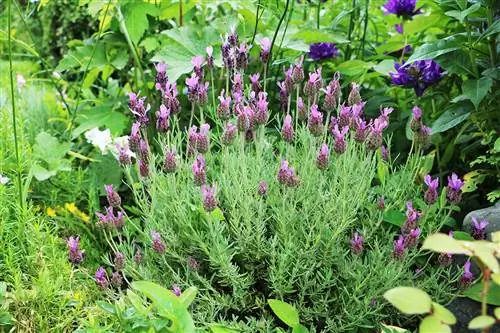
A rule of thumb for pruning is to shorten the plant BY about a third after flowering and TO a third after overwintering in the spring. However, the spring cut does not go into the old wood so that the lavender can sprout again in the same year.
The butterfly lavender is cut back heavily in early spring when budding begins. You can shorten it by half or even two thirds. However, you shouldn't cut into the old wood because it won't sprout again from there. Pruning is important for rejuvenation, otherwise the bushes become woody and bald and become unsightly. The lavender is blooming on this year's shoots. By cutting back, the plants grow particularly well and lushly.
Wintering
Butterfly lavender is not hardy and can only tolerate a few degrees below zero (minus 10 °C). Young plants in particular are particularly sensitive and require winter protection, even if they overwinter in a bright, cool and dry place in a frost-free room. With winter protection, planted lavenders become partially hardy, but should be covered with coconut mats, leaves or brushwood. The potted plants, on the other hand, overwinter cool but frost-free, as the pot or bucket freezes particularly quickly.
Before the cold season sets in, the plant is cut back. This means the plant is well protected from strong winds and drying out by the winter sun. In winter, watering is done very carefully, as waterlogging quickly leads to the death of the plant. At the end of the dark, cold period, the butterfly lavender slowly gets used to the sunlight. The planters, initially placed in the shade, are slowly moved into the sun to avoid burns.
Tips for speed readers
The butterfly lavender is easy to recognize, its upper flower spike is adorned with elongated, decorative false flowers. The “Kew Garden” variety with pale red and brown-red colored inflorescences is a speci alty among butterfly lavenders.
Frequently asked questions
Which substrate for the bucket?
Lime-free and as slightly sandy as possible, ensure good permeability.
Does butterfly lavender require pruning?
Cut twice a year (e.g. with scissors), otherwise the plant becomes woody.
Can the plant stay on the balcony?
If possible, overwinter in a frost-free, bright room. If the plant has to stay outside, wrap it well and protect the pot from freezing. Ventilate and check regularly.
What you should know about butterfly lavender in brief
- The shape of the inflorescence is very similar to a small version of a pineapple.
- Butterfly lavender is popular because of its eye-catching flowers and long flowering period.
- The plant is quite easy to care for. However, the plant pot should be protected in winter.
- Butterfly lavender is a beautiful container plant.
- Butterfly lavender needs a bright, sunny and warm location. Full sun is ideal.
- The plant absolutely needs lime-free soil. The substrate can be acidic or neutral, but in no case calcareous.
Butterfly lavender does not require much water. You keep it rather dry, but don't let the root ball dry out completely. Never water too much. Standing moisture is not tolerated. You only water when the top layer of soil has dried thoroughly. You should not fertilize lavender or only rarely. It is best to only fertilize when the flowering subsides. In soil that is too rich in nutrients, lavender often becomes lazy to bloom.

